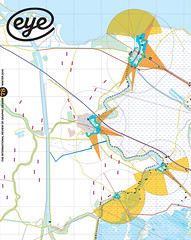Winter 2010
Type tales told for ordinary folk
Just My Type: A Book About Fonts
By Simon Garfield, Profile Books, £14.99It was hard to avoid Just My Type in the weeks before its publication in October, with excerpts featured in newspapers, in online magazines, and a free 50-page app (for iPad and iPhone).
Now designers can look forward to the day their formerly unenlightened friends will know the origin of lower-case, that someone designed the motorway signs, and that type on screen looks like that for a reason. But designers are very much not the intended audience: Just My Type is for the mainstream, people who are aware that the font menu in Word can fix as well as mess things up, that the distinguished chap with the ponytail in that documentary about type made sense, and how fascinating this Gutenberg press documentary was, and – well, probably not much else.
Just My Type breaks with a long tradition of books on typefaces, which almost without exception have been intended either for design students or professionals. Everything about this book suggests that display cases in Waterstone’s (or FNAC, or Barnes & Noble) are a higher priority than specialist bookshops; the profusion of images, however lighthearted in arrangement and tone, is there to reassure the reader ‘this is what we’re talking about, you’ve seen this before’.
The chapters are modest in length, and interspersed with bite-sized case studies of well known typefaces, reinforcing those ‘a-ha!’ moments for the general reader. There is an expert lightheartedness to the style of writing that – let’s be honest – is often missing from books on typography.
Garfield’s enthusiasm for type is obvious, and he has researched his subject well, drawing both on printed resources and a wide range of interviews. He makes every effort to convey how typeface design can be commercial, serious and sometimes pedestrian, while at the same time containing the capacity for reflection, surprise, joy and even indulgence.
He treats type’s esoteric, slightly obsessive personalities with respect for their skills and professionalism, and a hint of admiration for the level of achievement. He conveys well the disconnect between the designer’s world of minute details and the sweeping reception of type by the wider public as ‘just letters’.
Furthermore, he rejoices in explaining terminology, and does not hide his fascination with the technology of typemaking and typesetting. The book is all the better for it, since typeface stories are as much about tools and engineering problems as they are about emotive associations and reading the cultural moment.
If there is one complaint to make, it is that the text follows its sources a little too closely: there is a glaring omission in the absence of Unger and Swift from the story, and some distance from recent developments.
Having said that, Garfield clearly gets it, and understands how typefaces reflect an affluent society’s idea of itself, and contribute to the regeneration of popular culture. His stories have a focus on the personal that is usually absent from typographic narratives concerned with stylistic developments; he understands designers as both agents and generators of typographic currents. He also gets the growing importance of typefaces as screen rendering eliminates the material parameters of document identity.
The book runs out of steam at the end, leaving the story hanging in mid-air. Admittedly, it is difficult to weave many lesser stories into a coherent narrative, when hindsight of trends is incomplete. But, having established the mechanisms of emerging genres and cultural responses, Garfield should have had a stab at applying them to the present. He also misses the opportunity to introduce a general readership to some of the current discourse in typeface design, especially on internationalisation.
Just My Type offers an entertaining discussion of typeface design that is accessible, informative, and enlightening for a general audience. And for designers and typographers, it could be even more important: if it proves a commercial success, it will mark the point when type joined mainstream culture. So, go out and buy a couple of copies, to help the odds.
First published in Eye no. 78 vol. 20 2010
Eye is the world’s most beautiful and collectable graphic design journal, published quarterly for professional designers, students and anyone interested in critical, informed writing about graphic design and visual culture. It is available from all good design bookshops and online at the Eye shop, where you can buy subscriptions and single issues.

